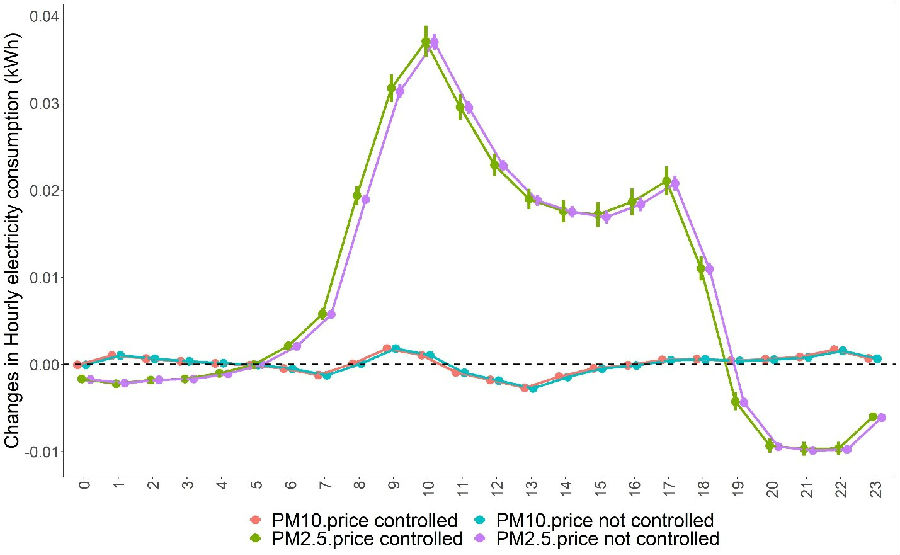While air pollution causes a series of health and economic losses, it may also cause changes in consumer behavior and energy production conditions, thereby changing the intensity of these losses. He Pan, a postdoctoral fellow in the research group of Associate Professor Liu Zhu from the Department of Earth System Science (DESS), Tsinghua University, collaborated with scholars at home and abroad to use statistical regression model methods and apply micro-level electricity consumption data to explore the changes in energy demand and supply caused by air pollution and the possible indirect loss.
This study takes the Phoenix Metropolitan Area in Arizona, USA as a case, using hourly residential and commercial building power consumption and solar power data from 2013 to 2018, and analyzes the impact of air pollution on residential and commercial building power consumption and power consumption from the demand side and supply side. The impact of distributed solar power generation. The model uses instrumental variable methods to solve the endogenous problems caused by the mutual cause and effect of air pollution and energy use, and combines high-precision power consumption records and survey data to accurately describe the energy use patterns of groups of different socioeconomic status and evaluate the impact of air pollution.
The analysis results show that the increase in the concentration of PM10 and PM2.5 will lead to a significant increase in residential electricity consumption, with PM2.5 having a greater impact. The reason for this result is that consumers may reduce outdoor activities to avoid the health loss caused by air pollution. As the time of indoor activities becomes longer, energy demand (including air conditioning, heating and various electrical appliances) may also increase. At the same time, the conversion of natural ventilation to mechanical ventilation may also bring about more energy use. Through further analysis of hourly data, this study found that this increase was mainly concentrated in the daytime, while energy consumption at night decreased. This may be due to longer time at home, causing consumers to move many activities that were originally performed at night (such as laundry and other housework) to the day. At the same time, low-income groups and Hispanic families are more affected. The possible reason is that consumers in disadvantaged socio-economic positions may have higher exposure levels to air pollution, and the energy efficiency of houses and electrical appliances may be lower. The increase in power consumption due to air pollution may be even greater. For commercial buildings, the overall impact of air pollution is not significant, but commercial buildings in retail, entertainment and service industries have seen an increase in power consumption, indicating that such commercial buildings have become alternative places for outdoor entertainment activities. On the energy supply side, both PM2.5 and PM10 concentrations will cause a decline in solar power generation, and residential buildings will be more affected. This may be because the degree of maintenance is lower than that of commercial building panels.

Figure 1. The coloured dots show the changes in hourly electricity consumption, obtained from panel regression at the hourly level. The coloured vertical lines show the 95% confidence intervals. As the information on hourly electricity price is available only for a small part of the residential and commercial samples, we conduct the analysis both with and without the regressor of price as a control variable.
As the current focus of environmental management in countries around the world, the prevention and control of air pollution is becoming more scientific and precise. In the design of pollution control policies, whether it is the formulation of control objectives or the selection of different policy tools, cost-benefit analysis is required to provide assistance and support for the decision-making process; the reliability of this analysis depends on the air pollution belt. To accurately measure health and economic losses. Existing researches mostly focus on the direct damage caused by exposure, and pay less attention to the loss caused by the impact of consumer behavior and energy production process. The results of this study show that when calculating the marginal damage caused by air pollution, policy makers need to explicitly consider the losses due to consumer behavior and the impact of clean energy technologies, otherwise they will underestimate the benefits of pollution control policies. And its promotion of energy equity. At the same time, the development of clean energy should consider the negative impact of air pollution and take corresponding measures (such as communicating the importance of cleaning and maintaining solar panels to residential users) to reduce this negative impact.
On September 21, the research results were published in Nature Energy, a research paper entitled Increase in domestic electricity consumption from particulate air pollution. He Pan, postdoctoral fellow in the Department of Earth Sciences, Tsinghua University, Associate Professor Qiu Yueming from the Department of Public Policy at the University of Maryland, and PhD student Liang Jing are the first co-authors and corresponding authors of this article. Li Qingran, a doctoral student in the School of Environment at Duke University, and Xing Bo, the lead analyst of the Salt River Project Provided important assistance in data collection, model construction and paper writing.
Paper link:https://www.nature.com/articles/s41560-020-00699-0
Author: Liu Zhu research group
Reviewed by: Wu Haiping
Photo typesetting: Fu Meijuan